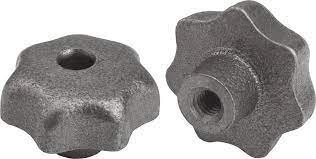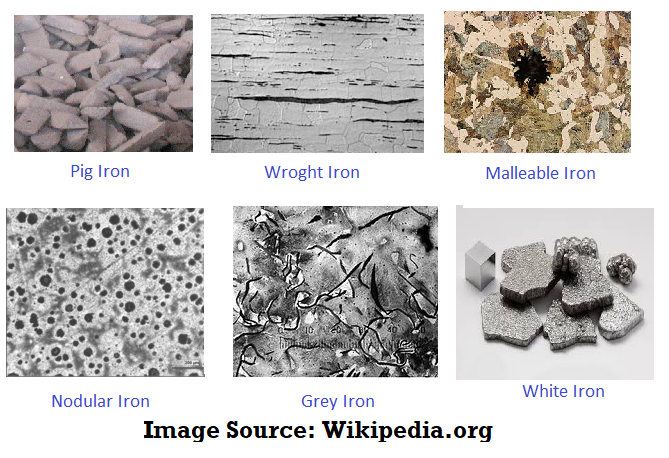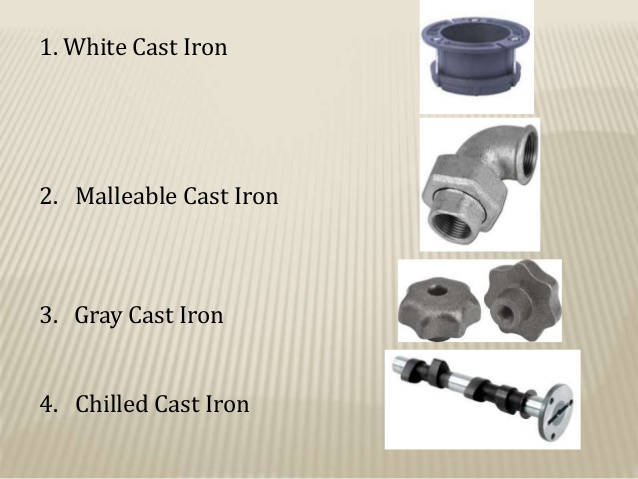Cast Iron and Its Types
What is a cast iron?
Cast iron are ferrous alloys with greater than 2% carbon.
They also contain small amounts of other materials such as silicon, sulphur, manganese, & phosphorous.
In general it consists alloys of carbon & iron.
They are the least expensive of all metals and is found plentiful resource than next to aluminium.

What makes cast iron an important material?
- It is a cheap metallurgical substance.
- Good mechanical rigidity and good strength under compression.
- Easy castablility.
- Good machinability can be achieved when a suitable composition is selected.

Composition :
- Carbon – 3.0 to 4.0%
- Silicon – 1.0 to 3.0%
- Manganese – 0.5 to 1.0%
- Sulphur – upto 0.1%
- Phosphorus – upto 1.0%
Influence of cooling rate on the properties :

Types :
- Grey (General purpose)
- White (Hard & Wear resistant)
- Malleable (Heat treated for ductility)
- Spheroidal Graphite (Some ductility)

Grey Cast Iron:
It is the least expensive & the most common type of cast iron.
It is an alloy of carbon & silicon with iron.

Composition:
- Carbon – 2.5 to 4%
- Manganese – 0.4 to 1%
- Sulphur – 0.02 to 0.15%
- Silicon – 1 to 3%
- Phosphorous – 0.15 to 1%
- Remaining is iron.
Characteristics :
- Good compressive strength
- Good torsional & shear strengths
- Good corrosion resistance
- Good Wear resistance
- Excellent machinability
- Outstanding sound and vibration damping capacity.
Applications :
Typical applications include;
Machine tool bodies, engine blocks, engine cylinders, brake drums, cam shafts, pipe & pipe fittings, household & agricultural appliances, etc.
2. White Cast Iron
White Cast iron derives its name from the fact that its fracture surface has white or silvery appearance.
Composition:
- Carbon – 1.8 to 3%
- Manganese – 0.25 to 0.8%
- Sulphur – 0.10 to 0.30%
- Silicon – 0.5 to 1.9%
- Phosphorous – 0.05 to 0.2%
- Remaining is iron.
Characteristics:
- Hard & Brittle
- High abrasion resistance
- High tensile strength & low compressive strength
Applications :
Typical applications include;
Production of malleable, rolls, wear plates, pump linings, balls;
Used for inferior casting & in places where hard coating is required as in outer surface of car wheels.

3. Malleable Cast Iron:
It is a cast iron that has been heat treated so that it has significant ductility & malleability.
Composition:
- Carbon – 2.0 to 3.0%
- Manganese – 0.2 to 0.6%
- Sulphur – 0.10%
- Silicon – 0.6 to 1.3%
- Phosphorous – 0.15 %
- Remaining is iron.
Characteristics :
- Good ductility & machinability
- High yield strength & tensile strength
- Excellent impact strength
- Not as brittle as grey cast iron
- High Young’s modulus & low coefficient of thermal expansion.
- Good wear resistance & vibration damping capacity
- Excellent machinability
Applications :
Widely used in automobile industries, typical components include brake-shoes, pedals, levers, wheel-hubs, axle-housings, connecting rods, transmission gears & door hinges.

4. Spheroidal Graphite or Nodular Cast iron
Spheroidal graphite (SG) is also known as ‘Nodular iron’ or as ‘ductile iron’.
Composition:
- Carbon – 3.2 to 4%
- Manganese – 0.2 to 0.5%
- Sulphur – 1.8 to 3%
- Silicon – 1.8 to 3%
- Phosphorous – 0.08% max
- Remaining is iron
Characteristics:
- Excellent ductility, tensile, & yield strengths than grey & malleable cast iron
- Good fatigue strength
- Good impact strength
- Hardness & high modulus of elasticity
- Corrosion resistance similar to that of grey iron
- Excellent castability & wear resistance
- Good machinability
- Ability to resist oxidation at high temperatures.
Applications :
Typical applications include;
Valves, pump bodies, crank shafts, gears, pinion, rollers, rocker arms, flanges, pipe fittings, power transmission equipment, earth moving machinery, & other machine components.

To learn more about Quality training on mechanical testing, Quality control Training for mechanical Engineers , Non Destructive Testing on Materials contact us at https://aqcinspection.com/training/
Visit our technical and career updates at our Blog site https://advancedqualitycentre.blogspot.com . or https://ndtcenter.blogspot.com

Thanks for this post…. Welder qualification Teat is a process which evaluates a welder’s capability to create welds to an industry standard following a welding procedure, this qualification can then lead to welder certification. Welder and welding procedure approval and certification have caused much debate over many years. There are several national and international Standards in existence that cover this activity (e.g. ISO, EN, ASME and AWS) but the main source of confusion centres on the body (or person) that is responsible for witnessing the testing and issuing of any resulting certificates.
ReplyDeleteZone Certification
Pipe Freezing Services
Storage Tank Survey
Thanks for this post…The Welder Qualification Test can be qualified by either radiography or ultrasonic testing; alternatively it can also be qualified by mechanical testing. The required number of testing is different from PQR and is less stringent. The Welder Qualification Test can be qualified by one face bent test and one root bend test. The bend test actually checks the ductility of the weld metal which is important factor in the depositing sound weld metal.
ReplyDeleteZone Certification
Pipe Freezing Services